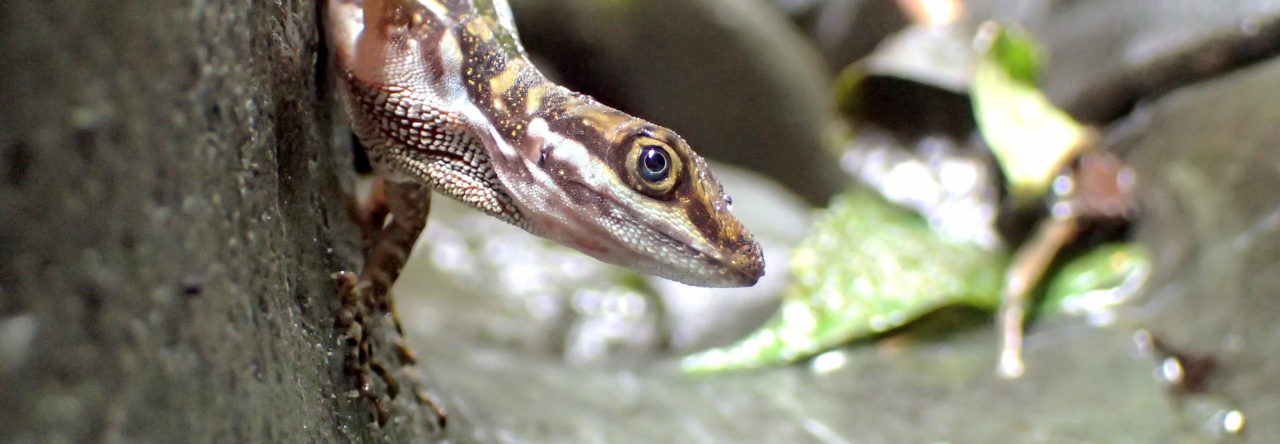
A Mid-Cretaeous lizard. This one individual’s long digits earned it the nickname “Nosferatu,” after the long-fingered German movie vampire,
When lizards prove too fast, slippery or downright squirrely to catch using other methods, herpetologists will sometimes turn to glue traps to snare their quarry. This technique is particularly useful when trapping elusive scansorial species (e.g. Bauer & Sadlier 1992, Ribeiro-Júnio et al. 2006), but is also proving useful for those of us who study fossil species. Sticky tree resin provides a naturally occurring glue-trap, and inclusions in fossilized resin, or amber, show that this material has been snaring and preserving small animals for many millions of years. Amber fossils are particularly important for three main reasons. Firstly, they preferentially preserve small, delicate specimens that are rare in the fossil record by dint of being too fragile to survive the fossilization process. Secondly, because they tend to be formed in tropical forested environments where decomposition happens rapidly and deposition is limited, they often contain snapshots of ecosystems that are rare in the fossil record. Finally, they preserve specimens in startling detail, often retaining soft anatomy at a resolution that no other fossilization process is capable of.
The term “Amber fossils” inevitably brings to mind images of frozen mosquitos, stuffed to the eyeballs with DNA-rich dinosaur blood and, while it is true that an enormous amount of arthropod diversity has been recovered from amber fossils, lizards have also been found in fossilized amber, from three continents and across six horizons that span 100 million years. Last year this blog discussed a series of anoles in amber that were featured in an impressive study by Sherratt et al. (2015) which documented the presence of ecomorphs 20 million years ago in the Hispaniola and Mexico. These fossils allow us to see directly into the past, and in the case of anoles, it was possible to document the early morphological diversification into some of the five basic ecomorphs (although, not all of them fitted in such categories).
 Earlier this month, a paper in Science Advances revealed the oldest amber lizard assemblage known to-date. This work is the result of teamwork between Ed Stanley, Phillip Wagner, Aaron M. Bauer, David Grimaldi and myself (Juan Diego Daza). We document the remains from 12 lizards that lived 99 million years ago in a tropical forest in an area of what is today Myanmar. Most modern lizards are pretty easy to identify to at least to family level–skinks have cycloid scales, geckos have toepads (not all), lacertoideans tend to have square scales, etc.–so naturally, you start looking for these traits in order to identify these animals. When I learned from my mentor, Dr. Richard Thomas, to use plastic bags in the field to collect lizards, these bags can be labeled and this makes sorting easy after a day of work. I remember the day that when we all met at the American Museum of Natural History with David Grimaldi; he started to bring plastic containers with small amber inclusions. It was like taking a Herpetology exam, and we kept asking each other, “what do you think it is?” You could only hear our wild guesses–gecko, skink, anguimorph, teiid, agamid–but none of us was entirely sure. This is because when these lizards were trapped, they looked very different to their modern relatives.
Earlier this month, a paper in Science Advances revealed the oldest amber lizard assemblage known to-date. This work is the result of teamwork between Ed Stanley, Phillip Wagner, Aaron M. Bauer, David Grimaldi and myself (Juan Diego Daza). We document the remains from 12 lizards that lived 99 million years ago in a tropical forest in an area of what is today Myanmar. Most modern lizards are pretty easy to identify to at least to family level–skinks have cycloid scales, geckos have toepads (not all), lacertoideans tend to have square scales, etc.–so naturally, you start looking for these traits in order to identify these animals. When I learned from my mentor, Dr. Richard Thomas, to use plastic bags in the field to collect lizards, these bags can be labeled and this makes sorting easy after a day of work. I remember the day that when we all met at the American Museum of Natural History with David Grimaldi; he started to bring plastic containers with small amber inclusions. It was like taking a Herpetology exam, and we kept asking each other, “what do you think it is?” You could only hear our wild guesses–gecko, skink, anguimorph, teiid, agamid–but none of us was entirely sure. This is because when these lizards were trapped, they looked very different to their modern relatives.
To determine the identity of these animals, we decided to look deeper, using a combination of light microscopy and high-resolution Computed Tomography (CT) to extract as much data from the specimens as possible.
Read More










 A
A 


 Earlier this month,
Earlier this month, 




 The caption says: At first look this image may just look like an Amazon green anole (Anolis punctatus) climbing a tree; but look a little closer… there is a cryptically coloured cricket fooling the predatory eyes of the lizard.
The caption says: At first look this image may just look like an Amazon green anole (Anolis punctatus) climbing a tree; but look a little closer… there is a cryptically coloured cricket fooling the predatory eyes of the lizard. 
